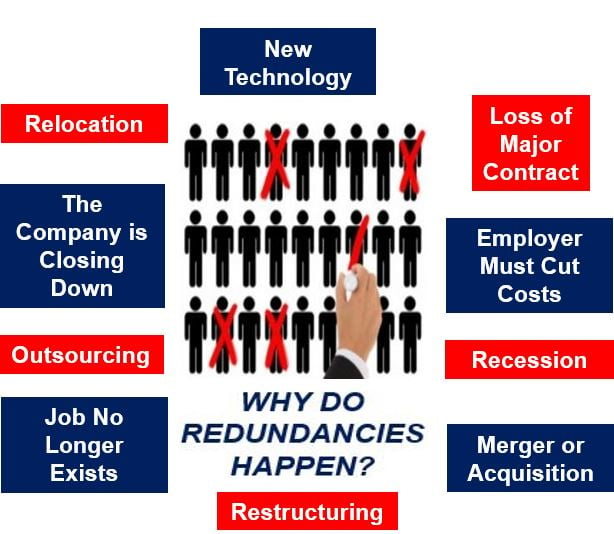Discussed: If a Company Goes Bust Who Pays Redundancy in the UK?
Discussed: If a Company Goes Bust Who Pays Redundancy in the UK?
Blog Article
Checking Out the Interaction In Between Company Redundancy and Organizational Versatility for Future Growth
In the vibrant landscape of today's organization globe, the intricate relationship in between business redundancy and organizational adaptability arises as an important element for continual development and success. Companies often face the challenge of striking a delicate equilibrium in between preserving a degree of redundancy to mitigate dangers and cultivating flexibility to respond swiftly to the ever-evolving market needs.
Importance of Business Redundancy
Business redundancy is an essential element that boosts organizational strength and alleviates operational threats. By including redundancy measures within the organizational framework, business can better hold up against unexpected disturbances and variations in the business atmosphere. Redundancy acts as a calculated buffer, permitting companies to adapt and react effectively to unexpected difficulties without jeopardizing necessary procedures.
One trick facet of the value of company redundancy is its function in making sure connection throughout times of situation. When faced with abrupt modifications or emergencies, redundant systems, sources, or employees can action in to preserve important features and prevent widespread interruptions. This continuity not only safeguards the business's online reputation and consumer depend on however additionally reduces financial losses and operational downtime.

Techniques for Organizational Flexibility

Another vital technique is investing in modern technology and facilities that can sustain adaptability and scalability. Applying digital tools, automation, and data analytics can streamline operations, enhance effectiveness, and supply beneficial understandings for informed decision-making. Furthermore, creating adaptable organizational frameworks that permit for quick adjustments to market characteristics and client needs is crucial for remaining competitive in a swiftly progressing setting. By proactively identifying prospective disruptions and possibilities, companies can proactively adapt and flourish in an ever-changing service landscape.
Harmonizing Redundancy and Adaptability
Achieving an unified stability in between operational redundancy and organizational versatility is critical in browsing the intricacies of a dynamic organization setting. Redundancy within a company offers a security internet, guaranteeing connection and stability in procedures. Nonetheless, an extra of redundancy can cause inefficiencies and hinder versatility to changing market conditions. On the various other hand, business flexibility enables firms to respond quickly to exterior disruptions and take new chances. Striking the appropriate equilibrium between redundancy and adaptability is a fragile process that calls for a deep understanding of the organization's goals, visit the site industry characteristics, and threat tolerance.
To achieve this equilibrium, business need to conduct routine evaluations of their operations to recognize locations where redundancy is necessary for threat mitigation and where adaptability can drive innovation and development. Carrying out flexible frameworks, promoting a society of continuous learning and improvement, and urging open communication across all degrees of the organization are key strategies to harmonize redundancy and adaptability properly. By lining up these two vital aspects, firms can position themselves for sustainable growth and success in an ever-changing company landscape.
Study on Adaptation Success
In checking out instances of successful business adjustment, it becomes apparent that the interaction in between functional redundancy and adaptability is a defining factor in forming durable businesses. A DVD rental service, Netflix showed amazing flexibility by transitioning into a streaming platform when digitalization interrupted the sector. These situation research studies underscore the significance of operational redundancy paired with organizational adaptability in cultivating lasting growth and competition.
Structure Durability for Future Growth
Structure strength for future growth requires a tactical placement of operational procedures with market characteristics and emerging patterns. Companies must adapt to changing environments by fostering a society of adaptability, advancement, and continual improvement.
In addition, cultivating strong relationships with stakeholders, such as consumers, Bonuses employees, suppliers, and the community, is crucial for preserving and weathering uncertainties trust fund and assistance throughout rough times. Effective communication and openness play a vital role in building durability, as they help line up assumptions and promote cooperation in navigating unpredictabilities.
Furthermore, companies require to prioritize understanding and development campaigns to upskill workers and furnish them with the necessary tools to adapt to transforming scenarios. By buying their labor force, business can enhance their versatility and dexterity, ultimately enhancing their resilience for lasting future development.
Verdict

In the dynamic landscape of today's business world, the detailed relationship in between company redundancy and organizational adaptability emerges as a crucial factor for continual growth and success. Companies frequently face the obstacle of striking a fragile equilibrium in click for more between maintaining a level of redundancy to reduce dangers and promoting versatility to react promptly to the ever-evolving market demands.To achieve this balance, firms require to perform routine assessments of their operations to recognize locations where redundancy is necessary for danger reduction and where versatility can drive advancement and development.In conclusion, the interplay between firm redundancy and organizational versatility is crucial for future development. Building durability through a combination of redundancy and adaptability will ensure that firms are prepared for the obstacles of the future.
Report this page